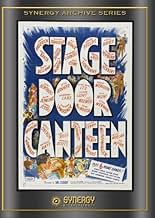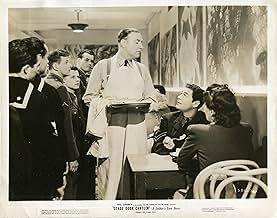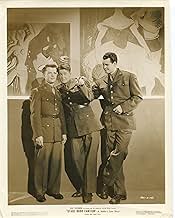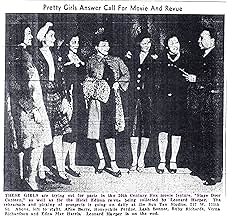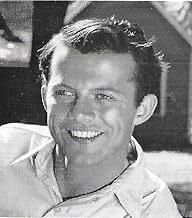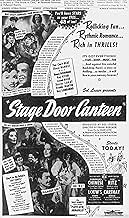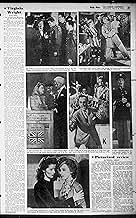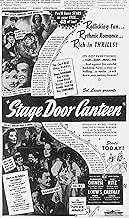Dakota, un joven soldado de Nueva York, visita el famoso Stage Door Canteen, donde aparecen famosas estrellas del teatro y las películas y albergan un centro recreativo para militares durant... Leer todoDakota, un joven soldado de Nueva York, visita el famoso Stage Door Canteen, donde aparecen famosas estrellas del teatro y las películas y albergan un centro recreativo para militares durante la guerra.Dakota, un joven soldado de Nueva York, visita el famoso Stage Door Canteen, donde aparecen famosas estrellas del teatro y las películas y albergan un centro recreativo para militares durante la guerra.
- Nominado para 2 premios Óscar
- 1 premio y 2 nominaciones en total
Reseñas destacadas
In fact, what comes across in the film is the easy camaraderie all the young men shared with people that otherwise they had never met in their ordinary lives. Meeting the likes of Tallulah Bankhead, a woman larger than life, was almost impossible for most of the people going to war.
Some of the best actors of that era are seen doing "supporting roles" in the film. Katherine Cornell, Paul Muni, Katherine Hepburn, Alfred Lunt, Lynn Fontaine, Ina Claire, Ray Bolger, Helen Hayes, are seen interacting with the GIs and as they give them hope and courage about an uncertain future of their lives.
The film is good to watch some of these long gone theater stars in a nostalgic look at our past.
I remember seeing it as a child in 1943 and have had it on tape for years and wonder why it has not been digitally remastered. The picture is scratchy and bumpy in parts, but nothing can spoil the innocence of our youth in uniform ready to go off to war.
Cameo appearances of so many entertainers on one stage give you an idea of what vaudeville and the big band era were like. There is no plot line or even a semblance of continuity in the performances of these stars, but all are polished appearances as if the casts were on tour. Their time was donated and their patriotism shows through loud and clear.
The story line involves a group of army enlistees who are given a mini furlough in New York City before they ship out. They are in awe of the big city at first but are told of a place where there is entertainment and free food. This, of course, is the canteen. Over the course of less than forty-eight hours, Dakota, Californa, Tex, Jersey, and others pair off with hostesses at the Stage Door Canteen. It is amazing how quickly love blooms in this setting. The hostesses have taken a vow not to get involved with the fellas, but how can they resist when they see the innocence, charm, and sincerity of the boys?
If there are starring roles in the storyline, they belong to California and Eileen, though they are not paired as sweethearts. California (LonMcAllister)looks like a teenager and is so likable. He has never kissed a girl! Eileen (Cheryl Walker) is torn between her duty to the canteen and her love for Dakota.
Some have said this movie is a morale booster or war-time propaganda. I like to think of it as the way things were during World War II.
In that sense, the film succeeds; I was actually rather moved by the final words each boy left for his girl at the end of the film. That doesn't mean the film isn't a little saccharine though; it *has* to be--it was meant to be a morale booster during the 1940s (including, as it does, songs about shooting down Japanese planes and marching into Berlin). It rides on the strong wave of American patriotism at the time, reflecting and hoping to add to it, and even hints at an internationalism unheard of these days (the crowd cheers for Russian soldiers and carries Chinese pilots on their shoulders in tribute to their bravery). If you strip it of these time-bound scenes, however, the message and the courage remains, which is what makes STAGE DOOR CANTEEN still a film that one can enjoyably sit through not just for the glamorous star cameos. It's sweet when California keeps trying to kiss Jean and missing out (including an incredibly frustrating final attempt when someone cuts in on them when they're dancing!), and you feel just as dejected as Eileen must when she realises that Dakota *isn't* coming back this time. (Let us, for now, leave aside the fact that I can't seem to find a redeeming quality in Eileen beyond the fact that she's willing to break the canteen rules to make it up to Dakota for being mean to him at first.)
The big-name entertainment in STAGE DOOR CANTEEN really can't be faulted: there are appearances by the orchestras of Benny Goodman, Xavier Cugat and Count Basie (to name just a few!); cameos by Merle Oberon, Katharine Cornell and Alan Mowbray; and a pretty literal striptease that ends way too soon for the boys' liking by Gypsy Rose Lee. My favourite numbers would be 'We Mustn't Say Goodbye' and 'Don't Worry Island', alongside Yehudi Menuhin's beautiful rendition of 'Ave Maria' (unfortunately given under some quite terrible lighting) and the very funny opening act with Edgar Bergen and Charlie. As, essentially, the final act, Hepburn gives her few words great weight and is as striking as ever with her five minutes (tops!) of screen time.
All in all, STAGE DOOR CANTEEN is great fun to watch. It'd be even better fun if one knew all of the people making cameos in it--I could only half-guess at most of them, and I'm sure I missed many many others. A sweet, patriotic film made with a very definite purpose, and if you make allowances for that purpose, it's easy to accept the overdoing of the message, and appreciate the film for what it is... good, clean entertainment!
Blink and you might miss (a few names for a taster) Tallulah Bankhead, Ina Claire, Judith Anderson, Aline MacMahon, Katherine Cornell, the Lunts, George Jessel, Ed Wynn, Ralph Bellamy, George Raft, May Whitty, Harpo Marx, Ned Sparks, and Dorothy Fields. You'll remember Katharine Hepburn as she goes all patriotic at the end of the movie.
Is it a good film? Probably not, but it is certainly historically interesting and probably has the most big names in one movie. The three soldier boys stand for all their compatriots who went to war'during both that conflict and the ones which followed. They aren't glorified, but are simply depicted as young lads who like dancing with girls and being treated with courtesy. We may never know what happens to California, Dakota, and Tex (and millions like them) but 'Stage Door Canteen' gives you a bit of their lives, and a snapshot of the wartime canteen.
¿Sabías que...?
- CuriosidadesThe real Stage Door Canteen at 216 W. 44th St., Times Square, was unable to be used for filming, as it was still an operating nightclub during World War II. As such, for this movie, it was re-created at R.K.O. Radio Pictures studios in Culver City, California.
- Citas
Katharine Hepburn: He knows what he's fighting for. He's fighting for the kind of world in which you and he can live together in happiness and peace and love. Don't ever think about quitting. Don't ever stop for a minute... working, fighting,praying until we've got that kind of a world. For you, for him, for your children... for the whole human race. Days without end. Amen.
- Créditos adicionalesAll rights granted by the American Theater Wing which gratefully acknowledges and credits the producers, stars and members of all the theatrical unions, guilds, crafts and associations for their participation in the creation and continuance of the original Stage Door Canteen.
- Versiones alternativasThere are two versions of this film --- one that runs two hours and twelve minutes, and a shorter television version, which runs one hour and thirty-three minutes (93 minutes), which is the most common one available.
- ConexionesFeatured in Gotta Dance, Gotta Sing (1982)
- Banda sonoraThe Girl I Love to Leave Behind
(1943)
Music by Richard Rodgers
Lyrics by Lorenz Hart
Sung and Danced by Ray Bolger (uncredited)
Reprised as dance music near the end
Selecciones populares
Detalles
- Duración2 horas 12 minutos
- Color
- Relación de aspecto
- 1.37 : 1
Contribuir a esta página


